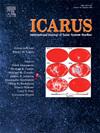Hypervelocity impact experiments in iron alloy targets
IF 2.5
2区 物理与天体物理
Q2 ASTRONOMY & ASTROPHYSICS
引用次数: 0
Abstract
In this work, we conducted hypervelocity impact experiments on iron alloy targets (FeNi36 and stainless steel SS304) at various impact angles using a two-stage light-gas gun. Our investigation focuses on the structure of impact craters formed on metallic targets, with implications for understanding potential crater formation on metal asteroids, such as those on Psyche. Our results show distinct differences in the crater morphologies of FeNi36 and SS304 targets, particularly in terms of crater size and rim features, which can be attributed to variations in material properties such as hardness and strength. We derived empirical equations from both our current experiments and previous studies with a wide range of iron alloy targets to estimate crater diameter and depth. The experimental results from our oblique impacts on iron alloy targets demonstrate that the variation in crater dimensions (i.e., depth, length, and diameter) primarily follow a sinθ relationship with respect to the impact angle. For metallic targets at oblique impacts, the material properties of both the projectile and target exert a significant influence on crater morphology, particularly at low impact angles, where they notably affect crater length. These findings may provide additional understanding of crater formation process on metal asteroids, such as those on the Psyche asteroid.
铁合金靶的超高速撞击实验
本文利用两级光气枪对铁合金靶(FeNi36和不锈钢SS304)进行了不同冲击角度的超高速冲击实验。我们的研究重点是在金属目标上形成的陨石坑的结构,这对理解金属小行星上潜在的陨石坑形成有重要意义,比如普赛克上的陨石坑。我们的研究结果表明,FeNi36和SS304靶材的弹坑形态存在明显差异,特别是在弹坑大小和边缘特征方面,这可以归因于硬度和强度等材料性能的变化。我们从目前的实验和以前的研究中得到经验方程,用于估计陨石坑的直径和深度。斜向撞击铁合金目标的实验结果表明,撞击坑尺寸(即深度、长度和直径)的变化与撞击角主要遵循sinθ关系。对于斜向撞击的金属靶,弹丸和靶材的材料特性对弹坑形态都有显著影响,尤其是在低撞击角度时,材料特性对弹坑长度的影响尤为显著。这些发现可能会让我们进一步了解金属小行星上的陨石坑形成过程,比如普赛克小行星上的陨石坑。
本文章由计算机程序翻译,如有差异,请以英文原文为准。
求助全文
约1分钟内获得全文
求助全文
来源期刊

Icarus
地学天文-天文与天体物理
CiteScore
6.30
自引率
18.80%
发文量
356
审稿时长
2-4 weeks
期刊介绍:
Icarus is devoted to the publication of original contributions in the field of Solar System studies. Manuscripts reporting the results of new research - observational, experimental, or theoretical - concerning the astronomy, geology, meteorology, physics, chemistry, biology, and other scientific aspects of our Solar System or extrasolar systems are welcome. The journal generally does not publish papers devoted exclusively to the Sun, the Earth, celestial mechanics, meteoritics, or astrophysics. Icarus does not publish papers that provide "improved" versions of Bode''s law, or other numerical relations, without a sound physical basis. Icarus does not publish meeting announcements or general notices. Reviews, historical papers, and manuscripts describing spacecraft instrumentation may be considered, but only with prior approval of the editor. An entire issue of the journal is occasionally devoted to a single subject, usually arising from a conference on the same topic. The language of publication is English. American or British usage is accepted, but not a mixture of these.
 求助内容:
求助内容: 应助结果提醒方式:
应助结果提醒方式:


